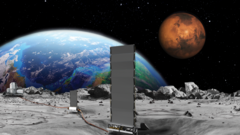Efforts are being made as countries, including the US, China, and Russia, rush to establish permanent human settlements on the Moon. The proposed nuclear reactor would serve as a continuous power source critical for supporting lunar infrastructure. However, experts caution that geopolitical considerations may overshadow scientific collaboration in space, with existing treaties like the Artemis Accords potentially complicating international efforts.
According to US media reports, NASA is keen to fast-track its Fission Surface Power Project to help establish a human presence on the Moon. Acting NASA head referenced the pace at which China and Russia are advancing their lunar plans, stating their ability to "declare a keep-out zone" could pose risks for US interests in space.
US Transport Secretary Sean Duffy has urged NASA to solicit proposals from commercial manufacturers to build a reactor capable of generating at least 100 kilowatts, a modest amount compared to typical sources. The idea of utilizing nuclear energy on the Moon is not new; in 2022, NASA awarded contracts to companies to design nuclear reactors specifically for the lunar environment. With the Moon's unique day-night cycle making solar power unreliable, many experts agree that nuclear energy will likely become essential for sustained lunar habitation.
Dr. Sungwoo Lim from the University of Surrey emphasized that relying solely on solar power poses challenges, underscoring that advanced nuclear reactors are a vital component of future lunar habitats to cater to human crew needs.
While some scientists speculate that launching a lunar nuclear reactor by 2030 seems feasible if funding allows, concerns linger about safety in transporting radioactive materials through Earth's atmosphere. The balance between the accelerated development of space infrastructure and adequate safety measures will be critical as discussions on establishing lunar sovereignty become more pronounced.
Critiques of the heightened focus on competition between nations rather than cooperation have arisen, particularly during a period when NASA's budgets face substantial cuts, raising uncertainties about upcoming missions. Some experts fear this renewed space race may distract from collective exploration goals as countries lay claim to portions of lunar territory.
Ultimately, NASA's plans for nuclear reactors on the Moon must navigate complex technological hurdles and the geopolitical landscape as they strive for progress in lunar exploration initiatives. The success of these ambitious projects hinges on international collaborations and securing the necessary funding amid growing rivalries in space.
According to US media reports, NASA is keen to fast-track its Fission Surface Power Project to help establish a human presence on the Moon. Acting NASA head referenced the pace at which China and Russia are advancing their lunar plans, stating their ability to "declare a keep-out zone" could pose risks for US interests in space.
US Transport Secretary Sean Duffy has urged NASA to solicit proposals from commercial manufacturers to build a reactor capable of generating at least 100 kilowatts, a modest amount compared to typical sources. The idea of utilizing nuclear energy on the Moon is not new; in 2022, NASA awarded contracts to companies to design nuclear reactors specifically for the lunar environment. With the Moon's unique day-night cycle making solar power unreliable, many experts agree that nuclear energy will likely become essential for sustained lunar habitation.
Dr. Sungwoo Lim from the University of Surrey emphasized that relying solely on solar power poses challenges, underscoring that advanced nuclear reactors are a vital component of future lunar habitats to cater to human crew needs.
While some scientists speculate that launching a lunar nuclear reactor by 2030 seems feasible if funding allows, concerns linger about safety in transporting radioactive materials through Earth's atmosphere. The balance between the accelerated development of space infrastructure and adequate safety measures will be critical as discussions on establishing lunar sovereignty become more pronounced.
Critiques of the heightened focus on competition between nations rather than cooperation have arisen, particularly during a period when NASA's budgets face substantial cuts, raising uncertainties about upcoming missions. Some experts fear this renewed space race may distract from collective exploration goals as countries lay claim to portions of lunar territory.
Ultimately, NASA's plans for nuclear reactors on the Moon must navigate complex technological hurdles and the geopolitical landscape as they strive for progress in lunar exploration initiatives. The success of these ambitious projects hinges on international collaborations and securing the necessary funding amid growing rivalries in space.
















